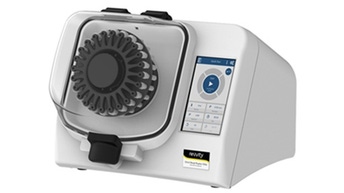Learn about our technologies
Biological and life sciences
Homogenizers are widely utilized in biological and life science research for the extraction of proteins, DNA, RNA, and other cellular components. They aid in cell disruption, tissue homogenization, and the release of analytes, allowing researchers to study cellular processes, conduct genomic analysis, and explore bio-molecular interactions.
Homogenizers are widely utilized in biological and life science research for the extraction of proteins, DNA, RNA, and other cellular components. They aid in cell disruption, tissue homogenization, and the release of analytes, allowing researchers to study cellular processes, conduct genomic analysis, and explore bio-molecular interactions.
Pharmaceutical and drug development
In the pharmaceutical industry, homogenizers are an indispensable resource in formulating pharmaceutical compounds, as well as pushing forward cutting-edge drug development assays.
They facilitate the blending of active pharmaceutical ingredients with excipients, ensuring uniform distribution and particle size reduction for lipid emulsion preparation, and encapsulation of drugs in nano-particle systems. Homogenizers also play a pivotal role in drug-development assays. By enabling a high-throughput and streamlined sample preparation workflow upstream of ADME and DMPK assays, the bottlenecks are eliminated allowing researchers to bring cutting-edge therapeutics to the pre-clinical and clinical markets.
In the pharmaceutical industry, homogenizers are an indispensable resource in formulating pharmaceutical compounds, as well as pushing forward cutting-edge drug development assays.
They facilitate the blending of active pharmaceutical ingredients with excipients, ensuring uniform distribution and particle size reduction for lipid emulsion preparation, and encapsulation of drugs in nano-particle systems. Homogenizers also play a pivotal role in drug-development assays. By enabling a high-throughput and streamlined sample preparation workflow upstream of ADME and DMPK assays, the bottlenecks are eliminated allowing researchers to bring cutting-edge therapeutics to the pre-clinical and clinical markets.
Food and beverage processing
Homogenization is a key process in the food and beverage industry. Homogenizers help create stable emulsions, prevent separation, and improve product consistency.
They are commonly used in dairy processing to achieve a smooth texture, prevent cream separation, and enhance product shelf life. Additionally, homogenizers aid in the production of sauces, dressings, juices, and other liquid-based food products.
Homogenization is a key process in the food and beverage industry. Homogenizers help create stable emulsions, prevent separation, and improve product consistency.
They are commonly used in dairy processing to achieve a smooth texture, prevent cream separation, and enhance product shelf life. Additionally, homogenizers aid in the production of sauces, dressings, juices, and other liquid-based food products.
Cosmetics and personal care products
Homogenizers play a vital role in formulating cosmetic and personal care products, such as creams, lotions, and emulsions.
They ensure the proper dispersion of ingredients, create stable emulsions, and allow for precise control of active ingredient addition. Using a homogenizer also helps to facilitate batch-to-batch consistency by use of programmable/semi-programmable functions.
Homogenizers play a vital role in formulating cosmetic and personal care products, such as creams, lotions, and emulsions.
They ensure the proper dispersion of ingredients, create stable emulsions, and allow for precise control of active ingredient addition. Using a homogenizer also helps to facilitate batch-to-batch consistency by use of programmable/semi-programmable functions.
Chemical and industrial applications
Homogenizers find applications in various chemical and industrial processes. They assist in particle size reduction, dispersion of pigments and additives in coatings and paints, preparation of stable emulsions for lubricants and fuels, and homogenization of suspensions and slurries.
Homogenizers contribute to improved product quality, consistency, and efficiency in diverse industrial sectors.
Homogenizers find applications in various chemical and industrial processes. They assist in particle size reduction, dispersion of pigments and additives in coatings and paints, preparation of stable emulsions for lubricants and fuels, and homogenization of suspensions and slurries.
Homogenizers contribute to improved product quality, consistency, and efficiency in diverse industrial sectors.
Featured resources


Filters
1 - 25 of 101 Resources
A novel method for the determination of cyclosporine in rabbit ocular tissues by LC-MS/MS
Automated homogenization and DNA extraction from murine GI tract tissue, cultures, and mock community for 16S sequencing
Automation of tissue homogenization in protein analysis workflows using the Omni LH96 automated workstation
Bead mill homogenization streamlines dermatomycoses organism identification by drastically reducing sample preparation time
Bead mill-based plant protein extraction efficiency is not dependent upon starting sample quantity
Beadless bead mill homogenization for protein extraction from soft rat brain tissue sections
Budding yeast homogenization: Consistent protein extracts with protein function retained
ChIP-seq analysis workflow from tissues using bead mill homogenization and PIXUL multi- sample sonication
Combining protein extraction using the Omni Bead Ruptor Elite bead mill homogenizer with detection of Phosphorylation events in mouse kidney samples using AlphaLISA immunoassay
Controlling sample temperature during bead milling using passive cooling with the Omni Bead Ruptor Elite 7 mL tube carriage
Controlling sample temperature during the bead milling process with the Omni BR-Cryo cooling unit
Detection of the bacterial 16S rRNA gene from soil samples using the Omni Bead Ruptor Elite bead mill homogenizer
Determination of pesticide recovery rates from spiked fruit and vegetables using QuEChERS extraction with bead mill homogenization
DNA extraction from Turbatrix aceti using the Omni Bead Ruptor 4 bead mill homogenizer
Drosophila melanogaster protein and DNA extractions using the Omni Bead Ruptor Elite bead mill homogenizer
Dry and wet grinding human hair samples with the Omni Bead Ruptor Elite bead mill homogenizer
Dry milling of analgesics for particle size reduction on the Omni Bead Ruptor 96
Efficient bacterial RNA extraction using the Omni Bad Ruptor Elite bead mill homogenizer.
Questions?
We're here to help.
Contact us Revvity is a trademark of Revvity, Inc. All other trademarks are the property of their respective owners.









































